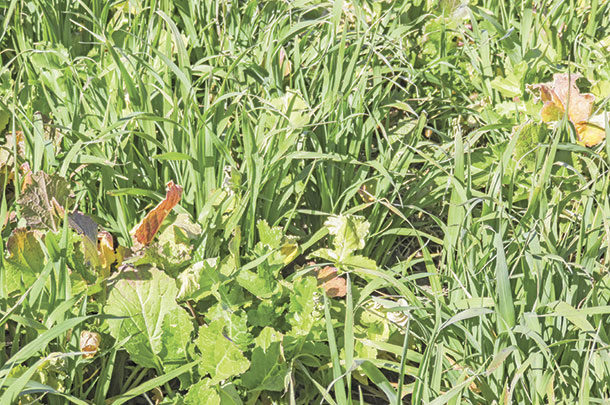Most people are familiar with the idea of planting oats in the spring as a forage crop, but late-summer-planted oats should not be overlooked, as it is a great option for grazing. Late-summer-planted oats don’t lignify as much, have lower fiber and higher amounts of water-soluble sugars than do spring-planted oats – thus, they are much higher in energy.
Late-summer-planted oats make a great candidate for fall forage production in annual forage systems (including corn silage) or as a forage crop following early harvested cash crops like wheat. Oats planted in early August in southeastern Nebraska have yielded around 2 to 2.5 tons of dry matter per acre and have been around 8 to 12 percent crude protein (CP) and 60 percent total digestible nutrients (TDN) when sampled in early November.
Delaying planting to late August will reduce yield somewhat (it typically yields 1 to 2 tons) but increases quality (15 to 20 percent CP and 75 to 80 percent TDN).
Along with oats, brassicas also make a great option for late-summer seeding. Brassicas are cool-season annuals that can provide a lot of high-quality feed for a small investment. Brassicas commonly used for forage include purple-top turnip, rapeseed, collards and hybrid turnips.
Purple-top turnip is the fastest-growing brassica, and both the leaf and bulbs (roots) can be grazed. Cattle seem to graze turnip leaves first and, if they remain on a field, they will go back and consume the bulb after the tops have been removed.
When a long growing period (90 days or more) is available, yields of rapeseed or hybrid turnips may be greater than purple-top turnips. However, with short growing periods (60 days or less), such as in double-cropping situations, yield of the purple-top turnip appears to be similar to rapeseed or hybrid turnips.
Brassicas do not fix nitrogen (N) but, due to their outstanding ability to scavenge N from the soil, they tend to have a high CP content with leaf/stem containing 15 to 30 percent CP, depending on N availability in the soil.
The digestibility of the leaf/stem does not vary much with late-summer planting (early or late August), resulting in TDN of 80 to 85 percent in early November. The bulb of the purple-top turnip is around 85 to 90 percent TDN.

The quality of brassica species commonly used for forage tends to be similar in late-summer-planted situations, so selection of brassica species should be based on yield potential (long versus short growing window) and cost.
Daikon oilseed radishes have also been included in mixes as they are thought to have soil benefits (like reducing compaction and improving water infiltration). From a forage standpoint, the nutrient content is similar to the other brassicas, but palatability appears to be less, as cattle tend to leave these for last.
Due to their high digestibility and low fiber, brassicas should be thought of more like a concentrate (grain) than a forage. They are low in fiber and thus another source of fiber is needed (such as hay) or planting with a grass (such as oats).
A suggested planting rate would be 40 to 60 pounds per acre of oats with 3 to 4 pounds per acre of turnip or rapeseed. Calves grazing after the forage has been frost-killed have gained between 1.5 and 2 pounds per day when grazing these mixes (Table 1).

What is the difference in forage quality? Not as much as one might think. The picture on the left (facing page) was taken in early November before a killing frost, and the picture on the right was taken a month later. The CP content of this forage was unchanged at 23 percent CP in both November and December, but the forage did lose 11 percent units of TDN (78 versus 67 percent TDN) over the month of November.
Late-summer-planted oats and brassicas can be an economical source of high-quality feed for fall-weaned calves or to put weight on thin cows. For those looking to produce more fall forage, oats “with or without a brassica” is worth considering. ![]()
PHOTO 1: Brassica foliage depicted in November.
PHOTO 2: Brassica foliage depicted in December. Photos provided by Mary Drewnoski.
Mary Drewnoski is a beef systems specialist at the University of Nebraska – Lincoln. Email Mary Drewnoski.














